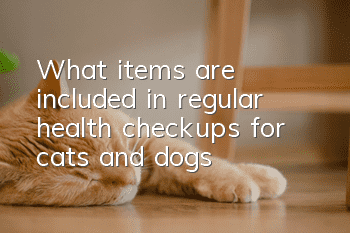What items are included in regular health checkups for cats and dogs?

Spring is the peak period of epidemics, not only for people, but also for pets such as cats and dogs. Parents who raise cats and dogs should focus on their pets recently to prevent epidemics. In fact, when parents first receive their pets, it is best to go to the pet hospital for a check-up and work with the doctor to make a long-term plan for their pets with vaccinations, deworming and regular health check-ups. This will make it easier for parents to understand the health and safety of their pets. Physical conditions. So, what are the items included in regular health checkups for cats and dogs?
Regular health examinations for dogs and cats are carried out 1-2 times a year, generally including the following:
Ask content. Including daily feeding and management, feeding food, growth and development, weight, vaccination, deworming and other dog and cat contact conditions.
Overall inspection. Including mental status, standing posture, movement, body temperature, breathing and pulse, etc.
Eyes. Normal dog and cat eyes should be bright, without secretions, and without swelling on the eyelids. If there is secretion, use cotton dipped in warm water and wash it.
Ears. Normal dog and cat ears are clean, without secretions and odor. If there is waxy secretion in the ear, you can use a cotton swab dipped in warm water, preferably ear drops, to clean it. When there is ear wax parasitism in the ear, black secretion will be produced, and it is necessary to seek treatment from a veterinarian. Some dog breeds, such as cats, poodles and setters, have hair growing in their ears, which needs to be trimmed regularly. The owner must pay attention to ear diseases and treat them promptly.
Nose. Normal dogs and cats’ noses are clean and moist, without any damage, and there is no secretion in the nostrils.
Oral cavity. Open the mouth of a dog or cat, and normal teeth and eyes will be pink. Check whether there are any abnormalities in the teeth of dogs and cats, and whether there is tartar on the teeth. Generally, check and remove tartar once every six months or a year. Check the lips for damage, etc.
Skin and coat. Use your hands to stroke the coat all over the body and check the skin for lesions, tumors, lumps, and cricket infestations. Ruffle the coat to check for fleas or ticks, dander or dirt.
Legs, toes and tail. Check whether the joints of the limbs and toes are swollen and abnormal, whether the claws are too long and have grown into the flesh, whether there are foreign objects between the toes, and the condition of the tail.
Anus. Check the anus and anal glands for infection and swelling, and for tapeworm segments on the anus.
Reproductive organs. Check the female dog and cat’s vulva for swelling and discharge, and whether there are lumps in the breasts. Check whether there are 2 male dogs and cats, whether the texture is abnormal, and whether there are any abnormalities and secretions from the foreskin orifice.
Abdominal palpation. Palpate for foreign bodies or tumors in the gastrointestinal tract, and for enlargement and texture changes in the liver, kidneys and other organs.
- Is there a difference between cat paws and dog paw prints? How to tell the difference?
- Does your cat refuse to be groomed? This is very important to her!
- Why is the cat twitching?
- Can cat heart disease be cured? Blood pressure and radiographic examination of cat heart disease!
- If a kitten meows as soon as it's locked in the cage, that's because you're not doing something right.
- Can cats bask in the sun?
- What are the causes of shortness of breath in cats? Shortness of breath in cats should not be underestimated!
- Can cats eat chicken bones? Why?
- What is the problem if a cat has purulent eye droppings in its eyes? What should a poop remover do?
- How to treat cat glaucoma



